Richard Rogers, Architect
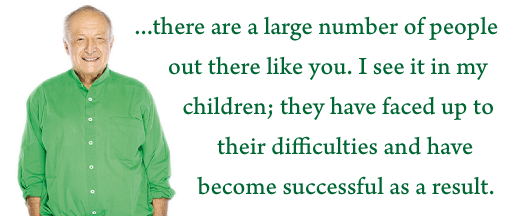
Architect Richard Rogers is perhaps best known for designing iconic structures like the Pompidou Centre in Paris, the Millennium Dome and the Maggie’s Centre in London and Terminal 4 Barajas Airport, Madrid. Trained at the Architectural Association in London and Yale School of Architecture on a Fulbright Scholarship, Rogers is one of the most sought-after architects of his generation. What many people don’t know is that Rogers didn’t learn to read until he was 11 years old and at the age of 6 he was caned by his headmaster for failing to memorize a poem.
Born in Italy to Anglo-Italian parents in 1933, Rogers was first exposed to contemporary art and furniture by his mother, a potter, and his father, a doctor.
In addition to designing buildings all over the world, Rogers has written books including Cities for a Small Planet. In 1995, he was the first architect invited to give the prestigious BBC Reith lectures. Among his numerous awards, Rogers is the recipient of the 2007 Pritzker Architecture Prize.
Rogers has five sons and lives in London with his wife, Ruthie, who is a founder of the River Café restaurant.
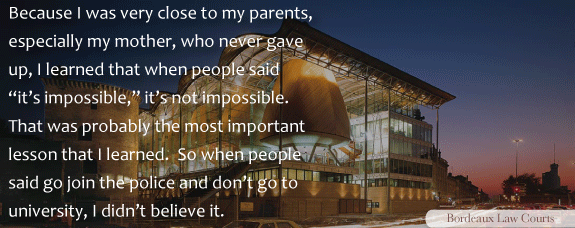
A Q&A with Richard Rogers by Alix Boyle
When did you first discover that you were dyslexic?
In my youth, in the 1940s, I was called stupid. Not only could I not read but I couldn’t memorize my school work. I was always at the bottom of the class. I became very depressed. When I was young, 7 or 8, I remember standing on the windowsill and saying “should I jump or shouldn’t I jump?” At that time, dyslexia was not really recognized. In fact, it wasn’t until I had my first child that I realized that I was dyslexic
Where did you go to school?
The first school I went to was called Kingswood House, in Epsom, near London. I also went to a special school for a year, which saved my life because they understood my difficulties and I realized that there were other students who also had great difficulties. I then went to the Architectural Association (college level), and on to Yale.
When did you first have an inkling that you were good at architecture?
There was no particular moment of realization, but a number of factors helped to influence my decision to become an architect. Growing up I was very close to my parents – my father was a doctor and my mother a potter and artist. They instilled me with a clear understanding of how, if we build well, we can create a socially inclusive environment. This has helped to drive my work. I also drew inspiration through my cousin, Ernesto Rogers who was probably one of the most important architects in Italy in the period following the Second World War. And going to the festival of Britain in 1951 was an enlightening experience – suddenly, it showed the potential of seeing what the world could be like; a window into the future.
How was school for you academically?
It was difficult during those first years. I went to an all-male elementary school, where art was seen as something that girls did. But I was brought up in a household that had modern paintings and furniture. My parents bought a couple of Picasso prints and our friends thought that they were out of their minds. By the age of 13, I was reading avidly about culture in a broader spectrum so I knew a little about modern architecture.
Do you read for pleasure today?
Although I started to read late, I have greatly enjoyed reading throughout my life. I have very good concentration, in other words, my mind doesn’t wander.
Do you think your dyslexia helps you see things in a way that other people don’t?
 People ask me that all the time….The Dyslexic Society in England asks me to speak to parents with children who have dyslexia and they ask “how did you do so well?”
People ask me that all the time….The Dyslexic Society in England asks me to speak to parents with children who have dyslexia and they ask “how did you do so well?”
I believe it important to have someone who believes in you and is supportive which in turn builds your confidence whether it is your parent, teacher or a friend.
I still don’t draw as well as most architects. There are a lot of architects who are dyslexic, the question is: do we have a better spatial understanding, which is what I say, or is it because we can’t do anything else? (laughs). I have a good spatial knowledge. Would I have lost it if I didn’t have dyslexia? I know a lot of people who have good spatial knowledge who are not dyslexic.
My father was a doctor, but I know that I could never have been a doctor. At that time I could not have gotten into university. I got into architecture school partly through the back door because I was older, more determined and pulled every string I could get hold of. I was interested from an early stage in social and political issues.
Can you talk about your way of thinking?
I have a good sense of space and I am good at solving problems. Learning by rote is impossible for me as I need to understand and absorb the problem I am dealing with.
I am interested in art, science, sociology and politics, which for me is the driving force in the design of buildings and public space.
I am very interested in the design and regeneration of cities and I am involved in the politics of architecture. When the Labour party came into power, I worked closely with John Prescott and the Deputy Prime Minister and I chaired the Urban Trade Force on the state of our cities. I was Chief Advisor on Architecture and Urbanism to former Mayor Ken Livingstone and have advised the current Mayor, Boris Johnson. I have also been an advisor to the Mayor of Barcelona’s Urban Strategies Council.
I am passionate about the design of cities. As to buildings, the Centre Pompidou in Paris, the very first large building I designed with Renzo Piano, is what I’m best known for and it does reflect my way of thinking.
It is a cultural center with a large public piazza in front of the building. It was designed to be a place for people of all ages, all creeds, the poor and the rich. One of my favourite buildings is Terminal 4 Barajas Airport, Madrid, which uses colors of the rainbow as a form of identification and to create both joy and orientation for users. We tend to embrace the use of color as one of the ways to strengthen the ‘mood’ of our buildings. Color also helps to emphasize certain rhythms, geometries and scales – you can see this clearly at Terminal 4.
You mention your mother was a huge help to you.
We worked together; I would read to her for instance, she taught me a bit of French. We had tutors. This was an advantage of being middle class as I had the opportunity to have an extended support network which is not available to those less fortunate.
Nowadays looking at my children, particularly the middle one who is the most dyslexic, one can be thankful for a more supportive system.
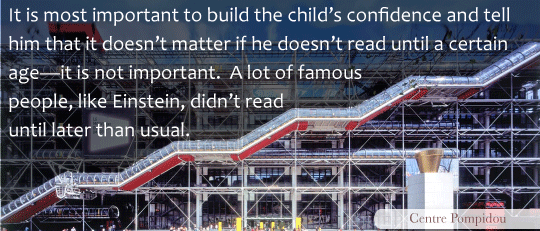
What advice would you give to young people with dyslexia?
Each individual child needs to seek professional help to first of all diagnose the problem and then to find out what is the best form of support. It doesn’t matter what sort of learning difficulty it is; with any type of learning challenge, those affected can see specialists and do courses and nowadays allowances are made for them in exams. It is most important to build the child’s confidence and tell them that it doesn’t matter if they don’t read until a certain age – it is not important. A lot of famous people, like Einstein, didn’t read until later than usual.
Were you allowed extra time on your exams?
No, no, no! I was just called stupid. I was always behind in the class. On the whole I wasn’t a difficult child. I had a group of friends, we called it a ‘gang’ back then. I was gregarious. People who are excluded from society tend to express themselves in ways not acceptable to society.
Who were your mentors?
My tutors at Yale and the Architecture Association such as Paul Rudolph, Serge Chermayeff, Vincent Scully and Peter Smithson, but I mainly learned from my partners such as Renzo Piano, Norman Foster and John Young to name but a few. And now I write books. Fortunately, my wife is very supportive and we work closely together. She can read my handwriting better than I can and I have a wonderful secretary. With computers now, the ‘spell check’ can figure out my spelling, but my middle son, who is a successful designer and is also dyslexic, says that spell check doesn’t understand his words, which is interesting.
Did you learn to speak a foreign language?
Yes, Italian was my first language and I came over to the UK when I was 6. Today I can speak Italian. My close friend, Renzo Piano, was Italian and we spoke Italian together. I retrieved it as an adult. I learned it by ear; I’m not good at grammar and so forth.
And I speak reasonable French having lived there for six years when Renzo and I built the Pompidou Centre.
What are you working on now?
Many projects around the world. A very large live/work/leisure development in Sydney, one of the towers for the World Trade Center site in New York and residential and commercial buildings.
Any final advice for people with dyslexia?
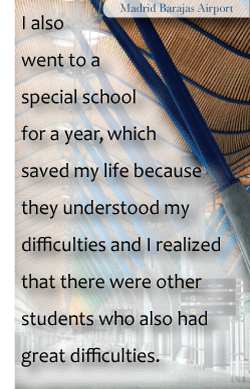 It is important to get a proper diagnosis as early as possible whether it is dyslexia or another learning difficulty, as it allows you to seek professional support from specialists. Families and friends are then able to work together to support one’s needs.
It is important to get a proper diagnosis as early as possible whether it is dyslexia or another learning difficulty, as it allows you to seek professional support from specialists. Families and friends are then able to work together to support one’s needs.
Getting diagnosed also means you’re part of a group–there’s a realization that lots of people have dyslexia or know someone that has it–and it puts you in a social and historical position. There’s a tremendous amount of information on the web and it brings more awareness of the challenges facing those people in their day-to-day lives.
We know an awful lot more now than we used to know about dyslexia. In the past, when the difficulty with reading arose, you hadn’t got a clue how to deal with it. It left you floating, saying, “Why can’t I read, when everyone else can?” Learning more about dyslexia helps you realize that there are a large number of people out there like you. I see it in my children; they have faced up to their difficulties and have become successful as a result.
Related

John Behrens, Director of Photography
John Behrens is a 42-year-old self-taught director of photography who is much too busy to blow time on boredom. He’s a sucker for a good story, fiction or fact, and he loves capturing it on film. He’s shot movies, feature and television documentaries, television programs, commercials, concert films, and he lives to shoot more. Working for everyone, from Metallica to Tesla Motors to Disney Pictures, and almost every television or cable network, Behrens feels his dyslexia makes constant challenge fun.
Read More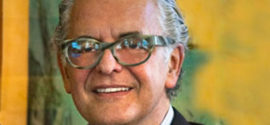
Samuel Botero, Award-Winning Interior Designer
Samuel Botero knows two things for sure. One is that being Samuel Botero is not easy. The other is that you need a sense of humor in this life.
Read More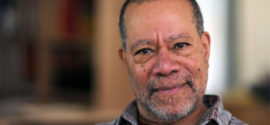
Jerry Pinkney, Children’s Book Illustrator
Before he became a legendary artist and illustrator of children’s books, gentle Jerry Pinkney was a little boy with a lot to do. By first grade he’d already figured out two important things: he had a gift with lines when it came to creating art, but an awful lag when those same lines formed letters for language.
Read More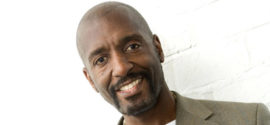
Willard Wigan, Artist & Member of the Most Excellent Order of the British Empire
The respect and appreciation have been a long time in coming, considering that as a schoolboy growing up in 1960’s Birmingham, England, he was ridiculed by teachers and peers alike for not being able to read. No one talked about dyslexia in those days, and so young Willard’s learning problems went undiagnosed, and his teachers told him that he was stupid and would never amount to anything. They paraded him in front of the classroom, and when he could not do the work, one of his teachers pointed to him and explained to the class that, “Willard is an example of failure.”
Read More